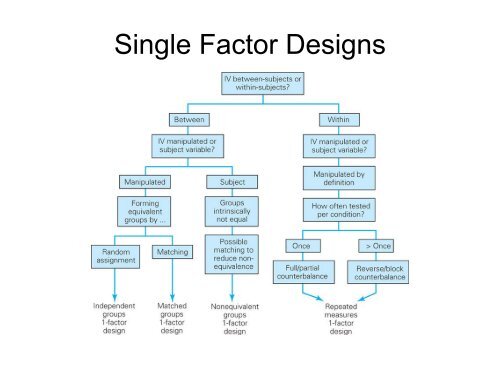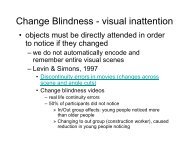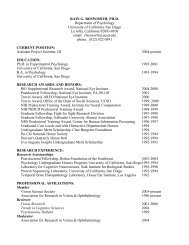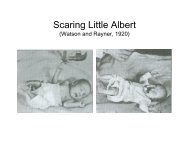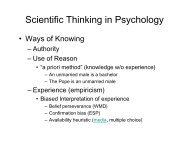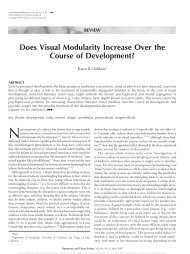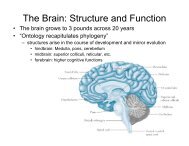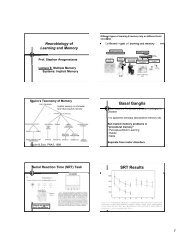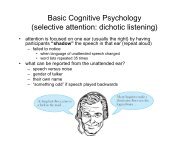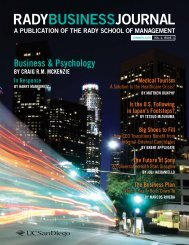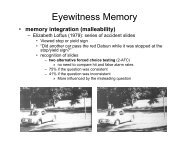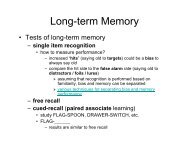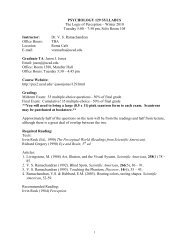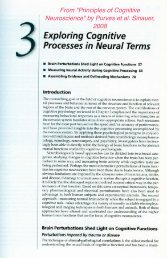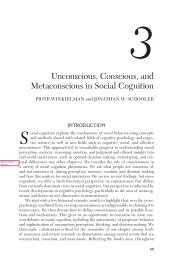Single Factor Designs
Single Factor Designs
Single Factor Designs
You also want an ePaper? Increase the reach of your titles
YUMPU automatically turns print PDFs into web optimized ePapers that Google loves.
<strong>Single</strong> <strong>Factor</strong> <strong>Designs</strong>
Between-Subjects Between Subjects, Two Levels<br />
• Independent Groups<br />
– random a do assg assignment, e t, many a y pa participants tcpa ts<br />
– e.g., typical experiments in social Psychology<br />
– independent groups t-test<br />
• Matched Groups<br />
– smaller number of participants<br />
– some factor strongly correlates with DV<br />
– e.g., sleep deprivation and suggestibility study<br />
– with one-to-one matching, use dependent groups t-test<br />
• Nonequivalent groups<br />
– subject variable<br />
– match the groups on other characteristics<br />
• bbut t not t necessarily il a one-to-one t matching thi<br />
– e.g., neuropsychology
Within-subjects, Two Levels<br />
• once per condition, use complete counterbalancing<br />
• twice per condition, use reverse counterbalancing<br />
– e.g., Stroop (1935)<br />
• more than twice, use block randomization<br />
– sometimes can use alternation (Lee and Aronson, 1974)
• <strong>Single</strong> <strong>Factor</strong>, Multi-level<br />
– Discover non-linear effects<br />
• Ebbinghaus percent savings<br />
• u-shaped u shaped dose curve<br />
– multiple control conditions<br />
• Mozart effect<br />
– multiple control groups<br />
• Bransford and Johnson (1972)
If the balloons popped, the sounds<br />
wouldn’t be able to carry since<br />
everything would be too far away<br />
ffrom the th correct t floor. fl A closed l d<br />
window would also prevent the<br />
sound from carrying, since most<br />
buildings tend to be well insulated insulated.<br />
Since the whole operation depends<br />
on a steady flow of electricity, a<br />
break in the middle of the wire<br />
would also cause problems. Of<br />
course, the fellow could shout, but<br />
the human voice is not loud enough<br />
to carry that far. far An additional<br />
problem is that the string could<br />
break on the instrument. Then<br />
there could be no accompaniment<br />
to the message. It is clear that the<br />
best situation would involve less<br />
distance. Then there would be<br />
fewer potential problems. With<br />
face-to-face contact, the least<br />
number of things could go wrong.
• Presenting Data<br />
– In the text<br />
– Tables<br />
• Exact values<br />
– Graphs<br />
• IV on X, DV on Y
• Types of graphs<br />
– Line graphs (continuous IV -- interpolation)<br />
• More than 2 levels<br />
– Bar graphs (discrete IV -- categorical)<br />
• or continuous with just two levels (immediate versus 24 hours)<br />
– Scatter plots (correlation)<br />
– Error bars (whenever possible!)
Multiple Pairwise comparisons<br />
• If there are more than 2 conditions, you may<br />
want to make more than one simple comparison<br />
(more than one t test)<br />
• what’s the level for 3 conditions with 3<br />
comparisons? What about J comparisons?<br />
• Wh What t about b t dependencies d d i bbetween t comparisons? i ?<br />
• Bonferroni inequality gives upper limit to observing one or<br />
more type I errors (≤J)
Control group designs<br />
– Placebo control groups<br />
– Waiting list control groups<br />
• can be combined with placebo p<br />
– Merikle and Skanes (1992)<br />
– Yoked control groups<br />
• Eye y Movement Reprocessing g and Desensitization<br />
– Dunn et al. (1996)
which test?<br />
Within Subjects Between Subjects<br />
matching<br />
2 levels 3 or more levels 2 levels 3 or more levels<br />
dependent<br />
Repeated independent<br />
independent<br />
groups<br />
measures groups<br />
groups<br />
tt-test test<br />
ANOVA tt-test test<br />
ANOVA
IVs (between, within, manipulated), DVs, design, scale (nominal,<br />
ordinal, interval, ratio), presentation (table, graph), analysis<br />
• College students in a cognitive mapping study are asked to use a<br />
direction finder to point accurately to three unseen locations that<br />
differ in distance form the laboratory laboratory. One is a nearby campus<br />
location, one is a nearby city, and the third is a distant city.<br />
• Three groups of preschoolers (50 per group, assigned randomly) are<br />
iin a study t d of f ttask k perseverance in i which hi h ddelay l of f reward d is i varied. i d<br />
The children in all three groups are given a difficult puzzle and told<br />
to work on it as along as they would like. One groups is told that<br />
they will receive a chocolate bar at the end of the session if they<br />
complete l t the th puzzle. l Th The second d group will ill get t a chocolate h l t bbar after ft<br />
20 minutes from the end of the session, and the third will get the<br />
chocolate after 40 minutes.<br />
• To examine whether crowding affects problem-solving performance,<br />
participants are placed in either a large or a small room while<br />
attempting to solve a set of word puzzles. Before assigning<br />
participants to the two conditions conditions, the researcher takes a measure of<br />
their verbal intelligence to ensure that the average verbal IQ of the<br />
groups is equivalent.


